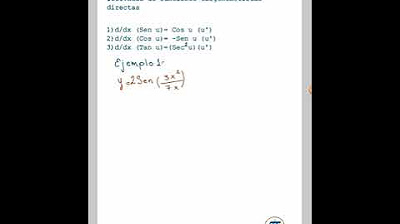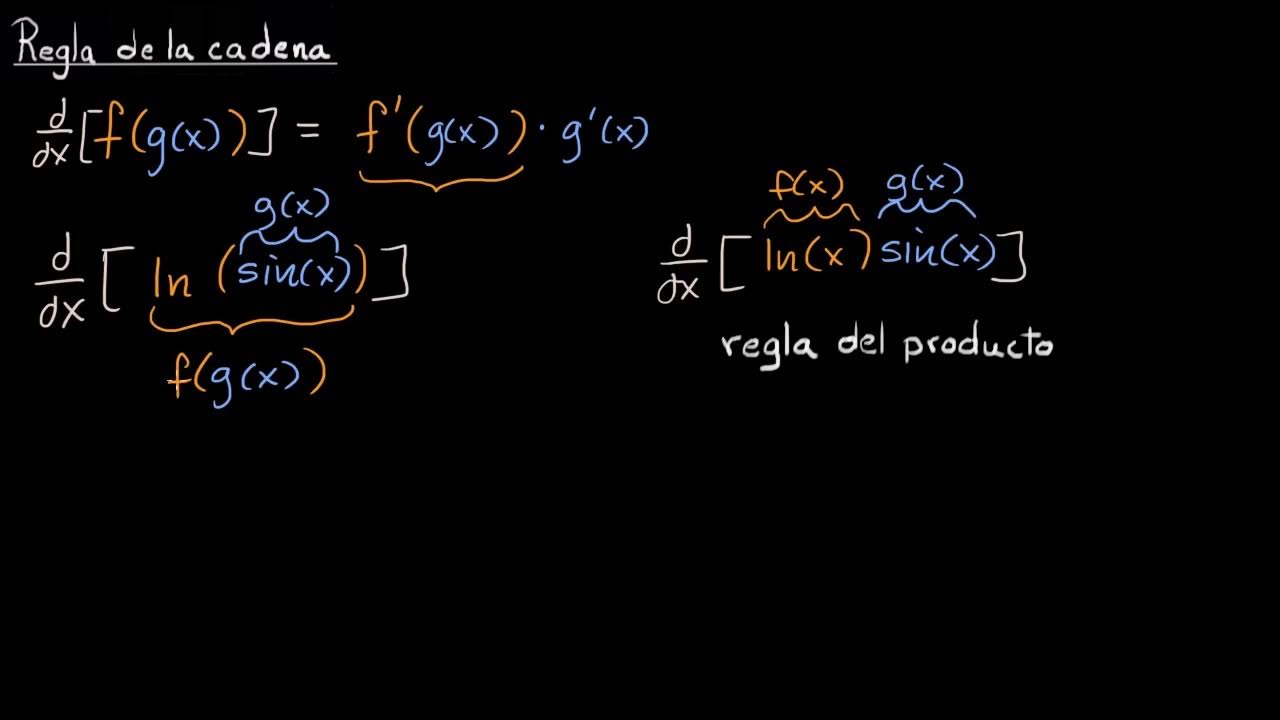Definición de la Regla de la Cadena y ejemplo
Takeaways
- 😀 The video starts with an abstract explanation of the chain rule in calculus, using a composition of two functions.
- 😀 The chain rule states that the derivative of a composite function is the derivative of the outer function evaluated at the inner function, multiplied by the derivative of the inner function.
- 😀 The example uses the function F(G(x)) to demonstrate the application of the chain rule.
- 😀 The derivative of F(G(x)) is expressed as F'(G(x)) * G'(x), where F' represents the derivative of the outer function and G' is the derivative of the inner function.
- 😀 The script emphasizes that this rule can initially feel abstract, but applying it to a real example makes it easier to understand.
- 😀 The example used for the real application is the square root function, √(3x^3 - x).
- 😀 To make the composition of functions clearer, F(x) is represented as √x and G(x) as 3x^3 - x.
- 😀 The rule is applied step-by-step, first by finding the derivative of the outer function with respect to the inner function, then applying the chain rule to the inner function.
- 😀 The derivative of the square root function, √x, is 1/2 * x^(-1/2), and this is modified to fit the composite function.
- 😀 The derivative of the inner function G(x) = 3x^3 - x is calculated as 6x^2 - 1, which is then multiplied by the derivative of the outer function to complete the chain rule application.
- 😀 The final result is that the derivative of the entire composite function is (1/2 * (3x^3 - x)^(-1/2)) * (6x^2 - 1), combining both the outer and inner function derivatives.
Q & A
What is the main goal of the video?
-The main goal of the video is to introduce the chain rule in calculus by first exploring an abstract form and then applying it to a concrete example.
How is the chain rule represented in the video?
-The chain rule is represented using a composition of two functions, expressed as F(G(x)), where F is a function of G(x).
What does the chain rule tell us about derivatives?
-The chain rule tells us that the derivative of a composition of functions is the derivative of the outer function evaluated at the inner function, multiplied by the derivative of the inner function.
What are the components of the chain rule as shown in the script?
-The components are the derivative of the outer function F, evaluated at G(x), and the derivative of the inner function G with respect to x.
What specific example is used to demonstrate the chain rule?
-The example used is the square root of a polynomial expression, specifically √(3x³ - x), which is treated as the composition of two functions.
How is the square root function treated in the example?
-In the example, the square root function is treated as the function F(x) = √x, which is then applied to the expression G(x) = 3x³ - x.
What is the derivative of the outer function, F(x) = √x, as shown in the video?
-The derivative of F(x) = √x is 1/2 * x^(-1/2), which is then evaluated at G(x) = 3x³ - x.
How is the derivative of the inner function G(x) calculated?
-The derivative of the inner function G(x) = 3x³ - x is calculated using the power rule, resulting in G'(x) = 9x² - 1.
How are the components of the chain rule combined to get the final derivative?
-The final derivative is obtained by multiplying the derivative of the outer function evaluated at G(x) by the derivative of the inner function. This gives the result: (1/2 * (3x³ - x)^(-1/2)) * (9x² - 1).
What colors are used in the script to highlight different components of the chain rule?
-Different components are highlighted in various colors for clarity: the function F(x) is in one color, G(x) is in yellow, the composition is highlighted in yellow as well, and the final derivative expression is enclosed in green and blue to distinguish the steps.
Outlines

This section is available to paid users only. Please upgrade to access this part.
Upgrade NowMindmap

This section is available to paid users only. Please upgrade to access this part.
Upgrade NowKeywords

This section is available to paid users only. Please upgrade to access this part.
Upgrade NowHighlights

This section is available to paid users only. Please upgrade to access this part.
Upgrade NowTranscripts

This section is available to paid users only. Please upgrade to access this part.
Upgrade NowBrowse More Related Video

Regla de la cadena para derivar funciones Cálculo diferencial por fernasol

Derivadas Regla de la cadena | Función compuesta | Ejemplo 1

15. Chain rule, FULL EXPLANATION and proof

Derivación Implícita | Derivada de funciones implícitas

Derivada de una función trigonométrica

Malentendidos comunes en la regla de la cadena | Khan Academy en Español
5.0 / 5 (0 votes)